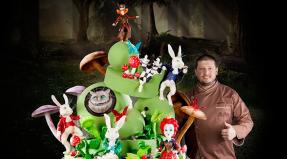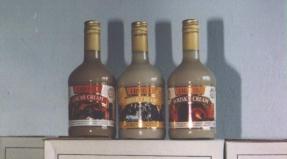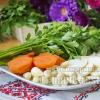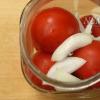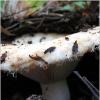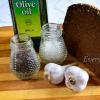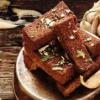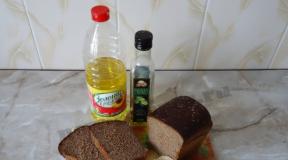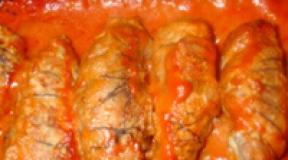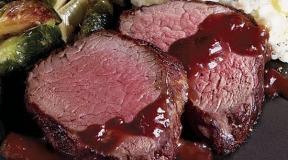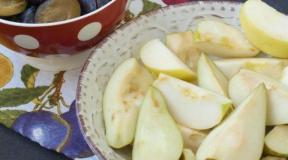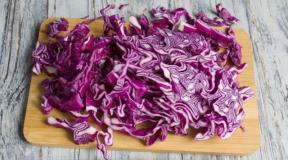Chinese vodka in the 90s. What did they drink in the USSR and how much did it cost (19 photos)
For the past week, social networks have been in a fever with a flash mob of memory of the 90s. Social media users posted their photos 20 years ago or more. medialeaks decided to devote the material to one of the most striking phenomena in the modern history of Russia - the emergence of a free alcohol market.
Everyone liked the joyful nostalgic photos. It is noticeable that in many pictures the characters are a little (or quite strongly) tipsy. We remembered ten iconic spirits of the first half of the 90s. Where did they come from, why were they popular, what did they taste like and what were they used with? We did not include well-known Western brands here (with the exception of Smirnoff), since they were not available to most at that time. We did not write the price of drinks, because in 92-95. there was hyperinflation and price tags changed almost every day.
Alcohol Royal 96%
Origin: alcohol for technical needs from Holland. According to rumors, it was mainly produced in Poland, like many other illegal products, where the term "scorched" came from.
Popularity secret: during the Prohibition era, alcohol became one of the shadow currencies, they tried to extract it even from denatured alcohol. By the beginning of the 90s, the rules were relaxed, but there was a catastrophic shortage of vodka in the country, it was sold on coupons. Royal appeared in the 91st and became the first affordable alternative to the products of the USSR wine and vodka factories. Due to its cheapness, it remained widely popular until the introduction of excise taxes in the 96th year.
Organoleptic qualities: Alcohol was diluted in a ratio of 1:2 to get a fortress of 40 degrees. Without additives and additives, even normal ethanol mixed with water is quite difficult to use. Not to mention fake alcohol. As a rule, something was added to this mixture.
Additional Ingredients: At the same time, dry juices were widely used: Zuko, Yupi, Invite. The bag of powder suggested "just add water." Naturally, alcohol was also added. Cheap and cheerful.
Homemade fruit liqueurs and vodkas 25-45%

Origin: the labeling of the place of origin was arbitrary.
Popularity secret: the first Russian businessmen realized the magical power of marketing: it is one thing when a consumer dilutes the powder with water with sugar and alcohol at home, it is quite another when he buys the same mixture in a beautiful bottle with a bright sticker and some funny name in Latin letters. So, for example, the recipe of Russian Baileys of that time is known: alcohol, boiled condensed milk, egg yolks. Similar products also disappeared in the 95th.
Organoleptic qualities: one recent study showed that even experts evaluate the taste of wine differently depending on its price: the more expensive the drink, the tastier it seems by default. The same applies to the design: Soviet citizens, accustomed to the same type of colorless labels, found everything bright by default to be attractive and tasty.
Additional Ingredients: A worthy accompaniment to such a drink was the fruit bubble gums that were widespread at that time: Mamba, Love is, Donald Duck.
Amaretto liqueur 21-30%


Origin: Italy, Poland.
Popularity secret: in 93-94 years. in some outlets one could find about two dozen varieties of a well-known brand. A characteristic feature was a square bottle. Perhaps it was in demand because it was considered a romantic drink and was often bought for dates. Being sweet and quite strong, it quickly acted on women. However, it is difficult to understand why almond flavor has become such a reliable tool of seduction.
Organoleptic qualities: dark brown sweet alcoholic drink with a bitter aftertaste and smell of almonds. Naturally forged in large quantities. It was rather difficult to drink it warm and clean, but that did not stop anyone.
Additional Ingredients: The best addition to a bottle of Amaretto was another foreign sweet: a Mars bar or Snickers.
Vodka Rasputin 40%

Origin: Germany.
Popularity secret: absolutely incredible advertising for that time, which looks quite good today. The 1993 commercial, in which a "magic" holographic portrait of Rasputin winked at the consumer as proof of the authenticity of the product, has become a true classic. However, holography did not save the brand from pirates, which undermined the confidence of buyers in it. It should be noted separately that the brand still has high recognition in Russia.
Organoleptic qualities: no one remembers, because during drinking it was customary to discuss the winking bearded man.
Additional Ingredients: At the same time, the practice of drinking vodka with lemonade spread. The most famous after Pepsi and Coca for a while was Hershey Cola.

Origin: USA
Popularity secret: in contrast to the 10s of this century, in the late 80s and early 90s of the past, the Made in USA sign was the best advertisement for any product. The name Smirnoff also captivated by the fact that it was a Russian surname, as it were, naturalized and recognized overseas. Surrealistic advertising also played an important role.
Following this, a lot of vodkas appeared on -off.
Organoleptic qualities: no one paid attention, the main thing was the bottle - a sign of success and new times.
Additional Ingredients: in 1992, raw-smoked sausage and some exotic fruit, say, a pineapple, were an indispensable attribute of a decent booze.
Wine "Monastic hut" and "Bear's blood" 10% -11%


Origin: Bulgaria.
Popularity secret: After the civil war began in Georgia, wine from there practically disappeared from stores, replacing cheap Spanish and Chilean at that time. At some point, it was simply impossible to buy something normal: it was either port wine or some kind of swill. Meanwhile, in big cities there were always enough wine lovers. Against the background of others, "Monastic hut" and "Bear's blood" favorably stood out in terms of price-quality ratio.
Organoleptic qualities: then it seemed quite decent semi-dry wine.
Additional Ingredients: black tea and guitar songs.
Sangria 7-9%


Origin: Spain, Germany, Bulgaria.
Popularity secret: a compote-like light alcoholic drink went well among young people, especially among those who liked to sit in the company, but did not like to get drunk, as an elegant alternative to beer. Another important advantage: a bottle of one and a half liters or even two liters cost, like the usual 0.7.
Organoleptic qualities: wine drink with a fruity aroma and minimal hangover effect. Many years later it turned out that this is a Spanish recipe for exhausting heat, fruits and lots of ice are added just before use.
Additional Ingredients: grapes, fruits.
Vermouth "Bouquet of Moldova" 16%

Origin: Moldova.
Popularity secret: until 1997, fortified wine was represented exclusively by the traditional “777” or “Agdam” in bottling. At the same time, as it turned out, inaccessible Martini and Campari are the same vermouth, that is, the "Bouquet of Moldova" is almost a noble drink. It turned out to be ideal for moderate drinking: it’s not a shame to treat a decent girl and everyone gets drunk not so quickly and gloomily. The place of "Bouquet of Moldova" in the second half of the decade was successfully taken by Salvatore and other inexpensive vermouths.
Organoleptic qualities: sweet drink with a pleasant herbal taste. An important feature: it was sold in a liter container. A bottle without a snack for two had a guaranteed effect.
Additional Ingredients: fried dumplings, chocolate "Alenka".
Gin&Tonic 6-7%



Origin: Finland, Poland, Russia.
Popularity secret: Another important consumer problem of the early 90s was the shortage of light cheap alcohol. Beer is a man's drink, girls need something more elegant. A jar of juniper soda was perfect for this role. Gin and tonic was the most popular alcoholic cocktail among high school girls long before Yaga.
Organoleptic qualities: carbon dioxide, a slight synthetic Christmas tree smell, and a bitter taste that masked the harshness of the alcohol well. One can after school was enough to get drunk, after two more on the same day I had time to get a headache.
Additional Ingredients: long menthol cigarette.
"Baltika" №№3 and 4


Origin: St. Petersburg.
Popularity secret: beer is the holy grail of the late Soviet drinker. Especially Western beer. In the 90s, a Tuborg or Heineken jar was more valuable than a bottle of vodka. After the collapse of the USSR, intoxicating drinks from Europe appeared on free sale, but at first they were quite expensive. "Troika", which was not inferior to foreign analogues, if not superior, became a real revolution and to a large extent laid the foundation for the success of domestic brewing. The second revolution was the “four”, because before that, dark beer was practically not sold in the country.
Organoleptic qualities: the usual Soviet "Zhigulevskoye" usually tasted rather nasty. Baltika Nos. 3 and 4 seemed absolutely fantastic at first. The author recorded cases when the first bottle of this beer was consumed by three people as if it were good cognac.
Additional Ingredients: to dark beer - light and vice versa.
PROLOGUE
On June 7, 1992, exactly 20 years ago, Russian President B. Yeltsin issued a Decree abolishing the state monopoly on vodka.
The first Soviet monopoly on vodka, which lasted 68 years and proved its effectiveness, was abolished from that moment. Since the middle of 1992, in Russia, anyone and everyone could produce, buy abroad and trade vodka on the basis of a special permit issued by the executive authorities, i.e. license based.
As a result, a large number of low-grade, low-quality, counterfeit, non-standard vodka-type strong alcoholic drink immediately appeared on the domestic Russian market.
The Russian market was overwhelmed by the flow of foreign pseudo-vodkas, and the share of vodkas with state quality guarantees has dropped sharply.
Foreign producers (primarily from Germany and Poland), about whom no one had ever heard of before, quickly realized that if their vodka was called in Russian, ending in “-OV” (- OFF), then this would be the most there is no “Russian vodka”, although in fact they had nothing in common with traditional Russian vodkas.
I haven't been able to find good photographs of vodkas from this period, with the exception of a few screenshots of the NTV chronicle.
For me, this vodka lawlessness of the early 90s was remembered from the other side. In my school years (during the period of late Brezhnevism), I was fond of collecting vodka labels. Not that this hobby is all-consuming, but I still managed to collect several dozen labels. Alas, there were almost no new labels in the Gorbachev years, and gradually I began to cool down to them. However, it was only in 1992 that dozens, if not hundreds of bottles with colorful labels with the word VODKA how the old passion flared up in me again. Alas, it quickly became clear that, unlike Soviet vodka labels, it was almost impossible to carefully remove a foreign one. Their glue (unlike ours) did not succumb to soaking under hot water.
As a result, I had to be content with just rewriting the names of this "good" that I saw, in the hope that someday I would find something somewhere.
Here is this modest list of 20 years ago.
ALEXANDER I VODKA
ALEXANDROW VODKA
ALEXOV VODKA
ARLANOV VODKA
ASLANOFF VODKA (Holland)
ATAMAN VODKA
AZOV VODKA
BARBAROSSA VODKA
BATUSCHKA VODKA
CETENOFF VODKA
REGULA (with a portrait of Nicholas II)
DAVIDOFF VODKA
DEMIDOFF VODKA (Germany)
DMITRIEY VODKA (Germany)
DONSKAJA VODKA
DUBRAVA VODKA
ELTZIN VODKA
ERISTOFF VODKA
FROLOFF VODKA (France)
FURST IGOR VODKA (Germany)
GAGARIN VODKA
GLASTOV VODKA
GORBATSCHOW WODKA
GORROFF VODKA
EMPEROR VODKA
IMPERATORSKAYA VODKA (the one in my collection)
IVAN GROSNYI VODKA
MERCHANT'S
KALINKA VODKA
KAPITANOV VODKA
KARKOV VODKA
KERMANOFF VODKA (France)
KOMANOV VODKA
KOMAROFF VODKA
KREMLYOVSKAYA VODKA
KULOV VODKA
KUTUZOV VODKA
LAVAROV VODKA
LVOVSKA VODKA
MENSHIKOV (Germany)
MADAM VALEVSKA VODKA
MAKAROV VODKA
McCORMIK VODKA
MOLOTOV VODKA
MOROZOFF VODKA
MOROZOFF VODKA (Germany)
MOROZOV VODKA
NIKOLSKI
NA ZDOROVIE VODKA
NIKOLAI VODKA
NIKOLAI II VODKA
OBRASOV VODKA
ORLOV VODKA
PETER DER GROSSE WODKA
PETROFF VODKA
PETROV VODKA
POLIAKOV VODKA
POMONOFF VODKA
POPOV VODKA
POTEMKIN VODKA
PUSHKIN VODKA
RASPUTIN VODKA (in addition to the official German version, there were at least two more versions of unclear origin with completely different labels)
ROGOSCHIN VODKA (Germany)
ROSSIA VODKA
ROSTOV VODKA
RUSKOV VODKA
POLBOVA
SELIKOV VODKA
SILVESTER VODKA
SIMEONOFF VODKA
SIROV VODKA
SHUKOFF VODKA
SMIRNOFF VODKA (famous, but it seems that under the American brand then the usual bodyagi was also sold)
SOKOLOV VODKA
STOLYPIN VODKA
STROGOV VODKA
SUVOROV VODKA (instead of the production address there was a concise - Europroduct)
TAMIROFF VODKA
TARANOV VODKA
TARAS KULAKOV VODKA
THITOMIRSKAYA VODKA (allegedly a US bottle, according to the label)
TOLSTOJ VODKA
TROYKA VODKA
TSARKOFF VODKA (France)
TZAR PETER VODKA
VORONOFF VODKA
YEROFEICH VODKA
ZARICA VODKA
One of these vodkas has been in my collection unopened for a good two decades. Even now I find it difficult to say whether this is normal vodka or just a foreign bodyaga of those years.
It is clear that in 1992 it was impossible to check whether such a company existed (Google did not exist yet), although I remember well that the seller assured me that this vodka was a “super-luxury category”, no doubt. Fuck knows, by the bubbles when shaking, it really does not differ from the current Premium class, but, alas, I will never be able to check this. This bottle will remain an unopened souvenir for me, bringing me back in my memories to the dashing 90s ...
EPILOGUE
A year later, the leadership of the country became clear all the perniciousness of the abolition of the state monopoly, and on June 11, 1993, the Decree of the President of Russia was issued "On the restoration of the state monopoly on the production, storage, wholesale and retail sale of alcoholic products."
The decree was aimed primarily at curbing the activities of various kinds of swindlers and dodgers who profit from the resale and counterfeiting of vodka, as well as protecting the interests of Russian vodka producers. The decree again restored in its entirety the state monopoly on the production and trade of this alcoholic beverage.
“If we recall the festive table of the late 80s, then very often it was quite monotonous both in terms of the set of dishes and “delicacies” and the set of alcohol. I remember well how my mother began to prepare for the New Year in advance, buying green peas, sprats and mayonnaise ... And my father filled the bar in advance with the same Soviet champagne and Stolichnaya vodka ... ”

A place of honor was occupied by some outlandish foreign bottle. And it doesn't matter what could be there - Havana Club rum, Smirnoff vodka or Amaretto sweet liquor. Foreign - it was already cool ...
It was already later, in the 90s, that shops and stalls were flooded with all sorts of Rasputins, Gorbacheffs, DaniloFFs, PetroFFs and other FFs. But there was also Royal alcohol, melon or lemon Stopka and a lot of “delicious” things. I can't even remember all the names. So, be reminded...

1. An invariable attribute of almost any festive table is Soviet Champagne. Most often bought semi-sweet and brut..

2. I have never met a dry one in our house. Somehow it was not popular with us in the family.

3. Permanent friends and regulars of festive tables). In the last years of the USSR, vodka in long bottles was increasingly scarce. Yes, and with a screw cap.

4. One of the representatives of wine classics
5. Bulgarian cabernet.
6. Brandy from Bulgaria. As students, for some reason, we really complained about him. Maybe because of the low price .. I do not remember.

7. The same Amaretto. They just drank it)

8. Just as they drank chistogan and Cuban rum. What are the mojitos...

9. Piano alcohol was at one point very popular, often replacing vodka. It was diluted in the right proportion and poured into a vodka bottle.

10. Megaclassic of the 90s. Advertising made this vodka one of the most popular in a very short time. Everyone knew the bearded man winking from the label

11. Another 90s classic. Smirnoff - that was cool. It doesn't matter if it was real or fake. The main thing is the label.

12. Another product of advertising popularity is White Eagle vodka.

13. A 30-degree Israeli shot was with different flavors - lemon, melon, something else. I remember September 1, 1996. We celebrated the check-in at the KhAI students' hostel. A melon stack under a watermelon ... For a very long time I could not look at either melons or watermelons ..

14. One of the many FF-ca...

15. Well, the theme of “great power” was also very popular

16. And the man named this vodka by his own name, thanks to which he became known throughout the country ...

17. Of course, how could I forget? Cognac Napoleon. The product of cooperation between the French cognac manufacturer Camus and the USSR, as a result of which Camus Napoleon became a symbol of French cognac. Well, later these Napoleons divorced like vodka - a million names.

18. Wine classic of the 90s. Bulgarian white wine Monastery Izba

19. ... and red "Bear Blood"

20. Top position of a good feast. Considered very cool Absolute
Golden autumn, 1 rub. 15 kopecks. - "Zosya"
Vasisubani, 2 rubles 00 kopecks. - "With Vasya in the bath"
Port 777, 3 rubles 40 kopecks - "Three axes", "Logging"
Bile mitzneh, 1 rub. 70 kopecks. - "Biomycin"
Import substitution, it turns out, was relevant in the days of the Soviet Union.
Vermouth, 1 rub. 50 kop. - "Vera Mikhailovna", "Vermouth"
Aroma of gardens, 1 rub. 80 kop. - "Fragrance of butts"
Autumn garden, 1 rub. 70 kop. - "Fruit-profitable"
Port wine 33, 2 rub. 15 kop. - "33 misfortunes"
Rkatsiteli, 2 rubles. 50 kopecks - "Doggy style to the target"
Caucasus, 2 rubles 50 kopecks - "The Beggar in the Mountains"
Anapa, 2 rubles 30 kopecks. - "Sunstroke"
Fruit wine, 1 rub. 30 kop. - Tears of Michurin
The most legendary "chatter" of the USSR
Port wine "AGDAM", alcohol 19 vol.%, price 2 rubles. 60 kopecks, - as soon as they didn’t call them - “Like ladies”, “Agdam Bukharyan”, “Agdam Zaduryan”, etc., etc.
This infernal mixture of fermented grape juice, sugar and potato alcohol was drunk by everyone in the country of victorious socialism - workers, students, academics.
Agdamych completed his victorious march across the expanses of the country only in the 90s after the destruction of the cognac factory in the town of Agdam, the most famous city of Azerbaijan, which is now completely wiped off the face of the earth as a result of the Karabakh conflict.
At the request of workers in the alcohol field:
Dessert drink "Volga Dawns", strength 12% vol., sugar-24%, price - 1 rub. 15 kopecks. - a glorious representative of the Soviet "Shmurdyaks".
As a rule, this "dessert" was tried only once, because. the second time, the urge to vomit began at the very first mention.
“Natural herbal tincture with tonic properties” is such a long name on the label of another legendary drink of the 70s - Abu Simbel Balsam.
Capacity 0.83 l., fortress 30 degrees, price - 5 rubles. 80 kop.
As experienced senior students enlightened us - elementary students: "Abu" is the best "boot-layer".
The cork, they taught, must be opened very carefully so as not to damage it, and the bottle must not be thrown away in any case: after emptying, it is necessary to pour ordinary port wine into it, carefully cork it and - everything is ready for the next romantic date!
And finally, one of the main "gifts" of N.S. Khrushchev to the Soviet people - the wine of Algeria, which, with the light hand of domestic "winemakers", turned into "Solntsedar", "Algerian" and "Pink Vermouth".
The people who survived, having tasted this muck, dubbed it “ink”, “paint for fences”, “insecticide”, etc., etc., but nevertheless, almost 5 million deciliters of this swill came to the Union by tankers, which with difficulty steamed after draining in the village of Solntsedar near Gelendzhik.
It was all about the price: "Alzhirskoye" - 14% and 65 kopecks !!!, "Solntsedar" - 20% and 1 rub. 25 kopecks!
The Solntsedar, which became a symbol of the era of stagnation, harvested its deadly harvest in the vastness of the USSR until 1985, when Gorbachev, who went down in the history of the country's wine consumption as the Mineral Secretary, began his fight against drunkenness and alcoholism.
"Moscow special vodka"
0.5 l, 40%, price 60 rubles 10 kopecks,
Dishes 50 kopecks, cork 5 kopecks. 1944 - "Kitch"
"Vodka" 0.5 l, 40%, price 3 rub. 62 kop.
1970 - "Crankshaft"
"Vodka" 0.5 l, 40%, price 4 rubles 70 kopecks.
1982 - Andropovka,
she, - "First Grader" (released in early September),
she, - "Yurkin's dawns" (according to the film)
Vodka "Russian" 0.33l, 40%,
I don’t remember the price, in a Pepsi bottle - Raiska
(in honor of the wife of the "Mineral Secretary of the CPSU" Gorbachev)
Vodka "Russian" 0.1 l, 40% - "Yogurt bum"
Vodka "Strong" ("Krepkaya-Strong"), 0.5 l, 56% alcohol.
This very rare vodka of the USSR period, with a strength of 56%. sold mainly to foreigners.
The legend about its appearance is associated with the name of Stalin: they say, the leader, who had a weakness for polar explorers, asked them at one of the receptions what they drink during the winter, to which they replied: alcohol diluted to the strength of the parallel, on which they the moment of consumption is at the Pole - 90%, Salekhard - 72%, etc., and already at the next Kremlin reception on the occasion of the award, Stalin treated the conquerors of the North with specially prepared vodka with a strength of 56%, which corresponded to the geographical latitude of Moscow.
Peppers are not only for colds!
And we went with her together, as if on a cloud,
And we came with her to Beijing hand in hand,
She drank Durso, and I drank Pepper
For the Soviet family, exemplary!”
After these lines, Alexander Galich simply does not want to tritely comment on this one of the most popular tinctures of the USSR, therefore, only the facts from the labels:
Bitter tincture "Pepper", 0.5 l, 1991,
35%, the price with the cost of dishes is 8 rubles 00 kopecks.
"Ukrainian horilka with pepper", 0.7 l, 1961,
40%, the price with the cost of dishes is 4 rubles. 40 kop.
There was still in the USSR Tincture "Pepper", 30%, has been produced since 1932, but for more than 30 years of collecting, I never came across a single bottle of it, because it was not just an infusion of different varieties of allspice and the first a remedy for a cold, but also a real holiday for all drinking citizens of the country of the Soviets.
I will continue (or rather start) the story about the beer of the 90s. Although I am more interested in dark beer, the paradox is that the first time I tried a dark sort of Soviet beer was when the USSR was already ceasing to exist, it was in the fall of 1991. Although this is not a paradox at all, but the consequences of a total shortage, as well as not well-thought-out measures to combat alcoholism (although now our new, Russian "dumas" are still eager to step on the same rake).
So, returning somehow from work (then it was NITSEVT - the Research Center for Electronic Computer Engineering, where I worked as a process engineer for 130 rubles a month) I saw that at the intersection of Varshavskoye Highway and st. There is a truck from which they sell beer from the Red Lighthouse. Quite a typical sight for Moscow at that time, but the beer was not quite ordinary - it was "Tverskoye" light and dark, in bottles of 0.33 liters. and at a sky-high price - 2 p. 50 k.! (Compare with my salary!). I didn’t save the labels, I’ll give you these (of those times), although they were case-shaped on pot-bellied bottles.
Beer made an indelible impression! Since then, I have always favored 14% light beers and dark beers. Unlike modern Russian mass beer (and indeed the whole world beer, since modern Russian is a typical example of mass beer all over the world), at that time other races of yeast were used, which did not ferment beer as much as it is now. Therefore, 14% light beer usually had a strength of 4.8% alcohol by volume (in our time, 6%, and often more). That is, it had a density almost like that of a "side" with a fortress like that of a "pilsner". Hence the powerful, dense, malty taste with a very moderate strength. Well, dark... Dark malts with their caramel, chocolate, coffee, burnt, as well as often raisins, prunes, wine and other nuances of taste made me an ardent admirer of such beer!
Tver beer began to appear regularly on that heel, and despite the price (and it also rose in price quickly - up to 2 rubles 90 k. - the times of hyperinflation were approaching), I took it regularly. A few years later, I even soaked the labels from these beers (I loved collecting artifacts) and they ended up being the start of my beer label collection. In the mid-90s, this beer looked like this:
In general, the Tver plant (later "Athanasius") at that time was very pleased with its beer. A stunning impression was made by their "Festive". It was a 20% dark beer with an incredible strength of 9-10% alcohol for those times! It was a port-caramel thick drink that rolled off your feet from a couple of bottles! This variety was apparently transformed into "Porter", which is still one of the best porters in Russia (and in the world).
I will also note "Our Mark" - this 18% light variety was created at the Badaevsky brewery for the 50th anniversary of the October Revolution. Even then, in Tver, dark beer was brewed more interesting than light beer, so a dark version of Nasha Marka was also released. Well, I will finish the story about Tver beer with another standard Soviet variety - "Admiralteyskoye". Although there is not much to tell about it - the usual light beer in the style of "Pilsen", but with a non-malt, it was simply remembered for shock gatherings in the glorious city of Savelovo, swimming in a nearby stream (in the month of May!), floating away in an unknown direction of money and morning hangover on the remaining trifle with that same pot-bellied bottle of Admiralty. Even the photograph has been preserved - on a pebble near the great Russian river Volga.

Near Chertanovo (near the Varshavskoye metro station), where I have been living for the past 40 years, there is one of the Moscow breweries - Moskovoretsky, built in 1959. While I was studying at the institute and buying beer in completely different Moscow districts, I practically did not come across Moskovoretsky products, but when I started working at NITSEVT and buying beer close to home, Moskvoretsky beer became the main one in my diet. I usually bought it in the market near the Prague metro station. For some time this plant was called JSC "Kolomenskoye". The main varieties were "Posadskoe" (analogous to "Zhigulevskoe") and "Slavyanskoe". The origins of "Slavyansky" lie in the good old "Pilsensky". In the 1930s, in the USSR, "Pilzenskoye" was renamed into "Russian", after the war "Russian" into "Rizhskoye". It was the only pure malt all-Union beer. But it was thoughtless to waste expensive malt, when the Soviet Union could not afford full of inexpensive barley or rice, so “Rizhskoye” was gradually taken out of production, and its place was taken by “Slavyanskoye”, developed just at the “Moskvoretsky” plant in the late 60s. x years.
In general, "Posadskoye" and "Slavyanskoye" were nothing interesting, ordinary light beer, quite clean, not strongly attenuated (by today's standards), so the taste was denser, hopping was not strong. These varieties were much more interesting:
"Moskvoretskoe" - a branded variety of the plant, 17% light beer, developed in the second half of the 60s. Due to the fact that beer did not ferment so much then (5% is modern 6.25% vol.), the best varieties then were precisely the most dense and strong. This continued until the release of "Baltika 9", and later "Hunting, strong", etc., where everything is fermented "to my very best" and therefore the taste of alcohol becomes dominant. After that, many dense varieties of regional breweries bought by multinational companies began to turn into "ruff-like" drinks. And then dense light varieties pleased with a dense, rich, powerful taste. Just a little wine. They were much more hopped than the light varieties, although this was not noticeable over the full malt body.
"Steppe" - I do not have a recipe for this variety, but there are strong suspicions that wormwood was used in it (hence the name) and later this variety was transformed into "Moskvoretskoye, original", where the presence of wormwood is indicated on the labels. This variety only increased my love for 14% light varieties. An excellent combination of dense rich taste and very moderate alcohol. The bitterness of this beer was higher than usual, but certainly nothing close to IPA.
The labels given above, following the Tver ones, were soaked from the bottles and put aside in an envelope until better times.
In the days of the USSR, beer was usually not pasteurized, its durability was 7 days (and often only three days really), so only local breweries were on sale. But since the mid-90s, pasteurization has become the norm, capitalist economic conditions have brought competition, the most successful producers began to distribute their products to new markets. Moscow was the most desired market, and by the end of the 90s the number of breweries represented on the Moscow markets was simply staggering, perhaps it was the most interesting time for a devout beer lover (let's not forget about the huge amount of imported beer imported before the crisis of 1998, when the ruble exchange rate was very high). Among the first noted in Moscow are the breweries of St. Petersburg - on the one hand, the second, but on the other, the first beer capital of Russia.
Somewhere in 1995 (or 96) in a store in the Zhavoronki village, next to my dacha, I saw an unfamiliar Kalinkin, anniversary beer - in pot-bellied bottles of 0.35 liters. This pale beer had 18% gravity and once again impressed me with the power of a malty, slightly vinous taste. The fortress was not felt, but the beer was drunk with a bang! The label was carefully torn off the bottle and joined the others. The beer was brewed at the St. Petersburg plant "Stepan Razin". It was this batch that was brewed for the 200th anniversary of the plant, which happened in 1995 (in fact, the date is very artificial, in fact, the Kalinkinsky plant itself is 50 years younger).
"Kalinkin" remained my favorite beer for a long time, I drank a lot of bottled and draft beer (not only in Moscow, but also in the homeland of beer - in St. Petersburg). And this is a good example of how a perfectly balanced density / strength beer has now turned into a banal "Hunt strong No. 2" at the behest of "Heineken".
The second St. Petersburg plant that actively began to develop the Moscow market was Baltika. Somehow my friend Vadim called and said that on Krasnoselskaya, an interesting beer with numbers was noticed in the store. As it turned out, it was Baltika No. 1, light, Baltika No. 2, special and Baltika No. 3, classic. By tradition, I kept the labels, and if here are exactly those that I soaked then, then it was September 1996.
Beer was bought and drunk under dried bream. But as it turned out, the bream here was not quite out of place. "Baltika" was one of the founders of "evropiva" in Russia. It was heavily fermented ("Treshka" at 12% density had 4.8% alcohol, that is, the same as the 14% variety). The taste was perfectly clean, only a slight fruitiness was felt, which did not go to dried fish. This beer should have been drunk on its own, its taste is light, akin to soda. Since then, there has been a debate on the Internet - what is better - a clean and faceless "Eurolager" or a full, but often dirty descendant of the Soviet brewing tradition.
After "Tverskoy, dark", I did not come across dark beers ("Festive", which I talked about, I bought towards the end of the 90s), so the next dark beers that I tried were "Baltika No. 4, original" and " Baltika №6, porter".
"Four" was bought in the same store on Krasnoselskaya, in the next delivery of products "Baltika" and only strengthened my love for dark beer. "Porter" was sold in a tent near the Leningradsky railway station. It was a bottle of 0.33 liters. The barcode on the back label was not Russian, but Swedish, which gave rise to rumors that Baltika brewed the first batches of Porter in Sweden. The taste was amazing - powerful dark malts, moderate sweetness, veiled strength. In general, the taste of "Porter" has not changed much since then. Although there was a moment when the barcode on the back label changed to Russian and the taste became too bitter-burnt, but it was a temporary failure. This beer was a rarity on sale, but it was always in the tent on Leningradsky and I went there often, although the price for this beer was higher, even taking into account the smaller volume.
That's it for now, I'll continue next time.
P.S. In my story, I omit imported beer, which by the mid-90s was not enough. Those German varieties that I drank then did not differ much from the same "Baltika", and the popular "White Bears" were just examples of "fermented to the very end" strong beer, in which, besides alcohol, there was little to be seen ...

